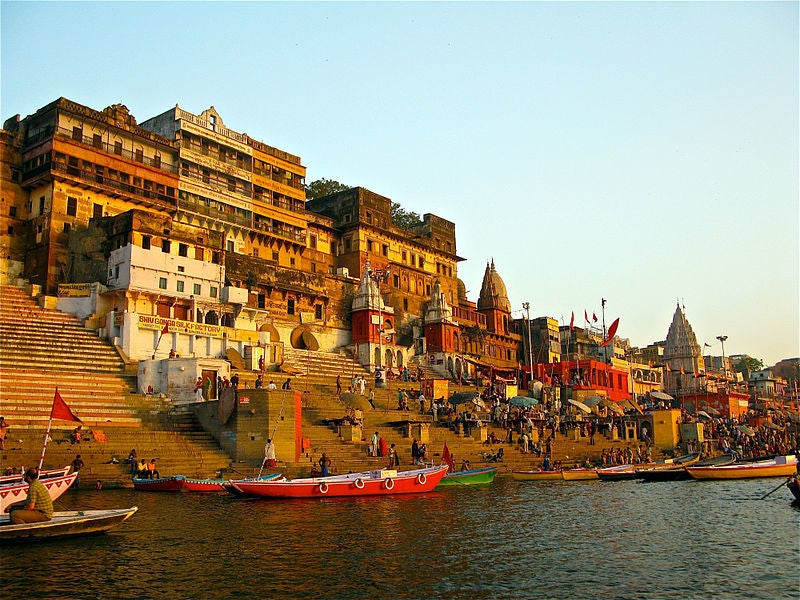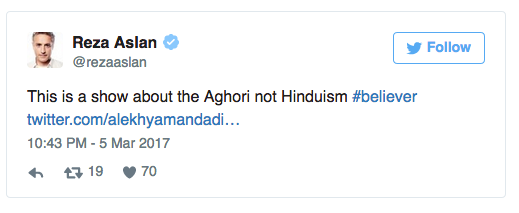March 6, 2017. By Parth Parihar, General Secretary of HSC
Growing up as a Hindu in America, I was often my friends’ only readily available resource about Hinduism. According to the Pew Research Forum, only 22% of Americans know a Hindu—the lowest percentage of any of the world’s “major religions”— making firsthand knowledge of my spiritual tradition a scarce resource for far too many. CNN’s airing of Believer, a documentary series about major world religions was therefore seen by many as an opportunity for so many Americans to learn about Hinduism and other less understood traditions. The memories of previous botched attempts were even papered over when the host of the series, Reza Aslan, laid out the premise of the show way back in 2015—
It’s an opportunity to show religious traditions, practices, rites and rituals that may at first seem weird and foreign and exotic and unfamiliar — because you’re unfamiliar with the metaphors underlying those ideas. At the end of an hour episode, they will all of a sudden become much more familiar and recognizable.
Cutting to 2017, however, as the premier of the show grew closer, cautious optimism was replaced by a knot in the pit of my stomach.
After the trailer of Believer’s first installment was released, public anxiety mushroomed. It soon become clear that the first episode would focus on the Aghoris, a small sect of Hinduism, an even smaller subset of which practices cannibalism. Varanasi, that beautiful and ancient city steeped in culture and tradition, would be reduced to “the city of the dead.” Substance would be replaced with sensationalism— one of the promotional videos—titled, “Face to Face with a Cannibalistic Sect”— recounts Aslan’s unedifying encounter with an Aghori baba. As Prof. Vamsee Juluri so eloquently points out in a typically brilliant piece on this platform, CNN’s portrayal of Indian spirituality in this episode does no better than the tired, racist stereotypes of “the old Indian Jones and the Temple of Doom sort of story.”
Written before the documentary aired, even that trenchant piece could not have anticipated all of the issues with the episode. Because as gruesome and problematic as Juluri makes the episode out to be, the actual thing turns out to be many, many times worse.
In this entire episode, Aslan appears to—inadvertently or not—play out the Trumpian strategy of “divert-and-conquer” that his ideological nemesis has thus far used with such ruthless efficiency. Here, even as the Hindu community rushes en masse to diffuse the fire of potential distortion that zooming in on the cannibalistic Aghoris can cause for a religion that is already so poorly understood in the West, each of Aslan’s voiceovers throughout the episode produces a misleading spark that, together, multiply into a full-on conflagration of “alternative facts,” engulfing the viewer in a false narrative by episode’s end. Indeed, while its focus on the Aghoris has an obvious potential for conflation with all Hindu pratice, what is truly most disturbing about Aslan’s work is the way in which it contextualizes the Aghoris within Hinduism and frames them as “reformist outcasts.”
The narrative constructed throughout the episode is basically this. Caste is a defining part of Hindu theology, stratifying society so that those on the lowest stratum are condemned to a life of shoveling excrement. Aslan notes that, “Hinduism is a beautiful religion” (read – ‘I’m not racist!’), but there is this “obstacle [of caste] he can’t get past,” that he “can’t wrap [his] head around.” Here, the Aghoris are a breath of fresh air. Because they believe, “God is within us,” Aslan tells us over and over again, they hold that nothing—not even working in the cremation grounds on the Benarasi ghats— can make us impure. Therefore, unlike the rest of Hindu society, the Aghoris are unique in accepting even the Dalits into their fold and allowing them a path to liberation (moksha). It is in search of this Aghori idea of openness that Reza journeys through Varanasi.
First, let’s tackle the discussion of caste, on which many of Reza’s assumptions rest. “Caste” is not, in fact, a Hindu concept (or word—it’s Portuguese) at all, but is a grotesque distortion of its teachings. The system of social classification in Hinduism is known as the varnashrama system.
The Bhagavad Gita— one of Hinduism’s foremost texts—describes this system as consisting of four varnas, which classify society into four groups based on one’s personal qualities. Bhagavan Sri Krishna notes that one becomes a Brahmin through knowledge, a Kshatriya through martial skill, a Vaishya through enterprise, and a Shudra through selfless service (BG 18.41 – 47). In fact, Krishna is sure to remind us that this classification is not based on birth by repeatedly using the phrase svabhava prabhavaih (“emanating from one’s nature”).
In one of Hinduism’s major itihasas, or epics, the Ramayana, Valmiki reminds us that the fruits of scriptural wisdom are available to people from any one of the varnas (Valmiki Ramayana 1.1.98 – 100). Finally, in the other major epic, the Mahabharata, when Bharadwaja inquires of Bhrigu why the varnas exist and what their distinction is, Bhrigu replies, “There is no real distinction… Brahman (God) created all men equal” (Shanti Parva, Ch. 188).
The exchange goes onto expound that differentiation between varnas comes from one’s acts—committed not in previous lives as Aslan erroneously claims in Believer— but in this one. The point of the varnashrama system, as Swami Prabhupada and others have put it, was therefore to provide a systematization to allow people to find the opportunities best suited to them in life, and to work towards perfection in their svadharma (i.e., life’s mission, personal role).
The point of bringing all this up is to point out that almost every sampradaya (sect) in Hinduism agrees with the idea that individuals cannot be pigeonholed into categories by birth and that spiritual guidance and moksha (liberation from the cycle of rebirth) is not restricted on the basis of birth. Yet, Aslan feels the need to search for a Hinduism “minus this obstacle [of caste]” by going to the Aghoris in order to provide a sensational, dramatic visual to his viewers—that of a crazed Aghori baba chasing him around the riverside. Such a visual is not true to the Aghori sampradaya, and it certainly isn’t true to Hinduism at large. This is all the more ironic since throughout the show Aslan lampoons the Aghoris’ “ostentatious cremation ground theatrics,” but here, it appears that he, too, has a desire for drama. Ratings, after all, are king.
If he was truly interested in a “casteless” Hinduism, he—as a scholar of religions—could have tried his hand at reading the Gita to better understand the spiritual world he was entering. If he was interested in only “lived experiences,” he could have traveled just up the ghats to the ashram of my family guru, Swami Ramkamal Das Vedantiji Maharaj, where dozens of children get a subsidized education, and polio camps are open to all, regardless of their background. Or, he could have ventured to any one of ISKCON’s centers, where the teachings of the Gita and Mahabharata are spread across the world through the message of bhakti.
Sadly, it appears the subject matter—the Aghoris—was chosen to maximize impact and a haphazard story of a “journey” was then supplanted for context afterwards, accounting perhaps for why the episode’s logical and theological mistakes are so numerous.
So numerous, in fact, that I will not have the space to get to all of them. Yet, I will recount just one more here. Throughout the episode, Aslan says the Aghoris believe that “God exists within each person,” and this theological metaphor therefore distinguishes them from the mainstream Hindu. The resulting overtone is that the ordinary Hindu thinks of God as sitting somewhere outside the Universe and judging how “impure” or “pure” we are. This is pure fiction; none of the Hindu sampradayas conceive of God in this way. In fact, in much of Hinduism, God is believed to both include and interpenetrate the Universe. The sixth verse of the Ishopanishad encapsulates this idea:
He who sees systematically everything in relation to the Supreme Lord, who sees all living entities as His parts and parcels, and who sees the Supreme Lord within everything never hates anything or any being.
This is the reason why Hindus are so “consumed by what we put into [our] bodies,” as Aslan puts it. Not because we are programmed by antiquated notions of purity, but because we see Brahman (God) as a cosmic force that binds us together with all other living beings. How, then, could we ethically consume meat?
This is not just about a community’s visceral reaction to visual cues; it is about a news agency putting out misleading, if not demonstrably false, information about a religious tradition. Effectively, “fake news.”
Aslan, for his part, has responded to the controversy by tweeting out that the episode was not about Hinduism, but just the Aghoris. In the face of all the connections he draws to Hinduism for context, and given that the whole point of his “journey” was to find Hinduism without caste, this claim is quite laughable.
In retrospect, it doesn’t surprise me that even Aslan— of all people— would not be more sensitive to the racist undertones his program winds up peddling. You see, as a minority in general, I’ve felt that liberals in this country have always had my back, but as a Hindu specifically, I’ve never thought they have. I see this when scholars who are so protective of other immigrant groups have no qualms in condescendingly lashing out when Hindu students ask questions about their work. I see this when, even as temples were attacked across the country and the Dotbusters assumed a new avatar as white nationalists, little concern was shown towards presenting Hinduism in textbooks with greater accuracy or sensitivity to promote mutual understanding in future generations. As Juluri points out, Srinivas Kuchibhotla’s name escaped Hollywood’s conscience, though he’d been shot three days before the Oscar’s.
It’s possible that even now—as happened to so many with the California textbook controversy—my words will be twisted to suggest that I am insensitive to the plight of so many due to casteism. The truth is I believe that it is an abhorrent practice; my desire to disconnect it from my religious tradition should be seen as evidence of this fact. And I do think that we Hindus need to do way more to combat it.
But is using caste to falsely contextualize a remote spiritual practice going to serve any progressive end? Aslan claims his purpose was “to make the exotic less exotic, make the fearful less fearful, make people realize that they have a lot more in common with each other than they would possibly imagine.” If this was his goal, then the show has succeeded in accomplishing exactly the opposite.
Reproduced from Huffington Post at the following link: http://www.huffingtonpost.com/entry/misleading-and-sensational-cnns-believer-pilot_us_58bdff16e4b0aeb52475fe7f

